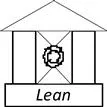Chapter 1
IT in a World of Continuous Improvement
Publisher Summary
This chapter introduces a book that deals with enabling IT value and increasing its flow while reducing IT waste through presenting reference architecture for an automated and integrated IT management system. In applying architectural methods to a given domain, that domain must be well understood. Users must go to the real, operational heart of the problem trying to be solved. This introductory chapter starts with the underpinnings for an architectural exploration of large-scale IT management focusing on what is “Information Technology,” what is a “Service” and an “IT service,” a discussion on “Lean,” what an “IT Value” is, how to improve the delivery of “IT Value” through concepts such as Lean, and the relationship of Lean IT to other industry trends in IT. There are many discussions in the field of information technology, and many of them stem from basic questions of definition. To discuss IT value and the specific practices and tools needed to enable it, one needs to pay attention to fundamental principles and definitions. Information technology is assumed to encompass well-known historic variants such as “Information Systems,” “Data Processing,” and “Management Information Systems.” IT is about computing practices and assets applied to enterprise needs.
Discussions of IT management struggle when they are not grounded in fundamental principles. This chapter sets forth working definitions of “Information Technology,” “IT service,” “Lean,” and “Lean IT.” Basics of Lean and related continuous improvement are presented, with cautions as to their applicability in an IT services context. Proposed is the concept of two axes of IT value (product versus transactional). Establishing a correct analogy between IT and manufacturing operation is discussed, and the equation of IT transactional delivery with an assembly line is proposed and contrasted with the failed concept of software assembly line. Quality management in IT is summarized from a Lean perspective, and IT waste is discussed. Current trends in IT management are examined from a Lean light and a “TPS house” for IT is proposed. The Lean concepts of flow, small batches, kanban, and other terminology is presented.
Keywords: IT Service Management, Lean IT, IT Value, IT quality, Deming, Goldratt, Theory of Constraints, kanban, flow, IT waste, IT trends
Problem Statement
Massive IT capital investments and supply chains, critical operations, and pivotal implementation initiatives are managed with emails, spreadsheets, and seat-of-the-pants intuition, with narrow and parochial goals elevated over global objectives.
Too often absent is the data-driven, analytic, continuously improving management philosophy employed in the primary value chains of the world’s most successful companies.
This is a book on enabling IT value and increasing its flow while reducing IT waste through presenting a reference architecture for an automated and integrated IT management system.
In applying architectural methods to a given domain, that domain must be well understood. We must “go to
gemba,” in the words of Toyota’s Taiichi Ohno; in other words, we must go to the real, operational heart of the problem we are trying to solve.
This introductory chapter therefore starts with the underpinnings for an architectural exploration of large-scale IT management:
1. What is “Information Technology”?
2. What is a “Service”? What is an “IT service”?
3. What is “Lean”? Where did it come from?
4. What is “IT Value”?
5. How can we improve the delivery of “IT Value” through concepts such as Lean? “Lean IT”?
6. What is the relationship of Lean IT to other industry trends in IT?
In order to discuss IT value, we need to pay attention to fundamental principles and definitions.
There are many passionate discussions in the field of information technology, and many of them stem from basic questions of definition. In order to discuss IT value and the specific practices and tools needed to enable it, we need to pay attention to fundamental principles and definitions. The next section establishes a series of related principles that both support the architectural analysis and serve as high-level scoping and requirements for our value system.
What Is “Information Technology”?
Information Technology (IT) is about computing hardware and software applied to enterprise needs.
In order to write about “Information Technology” and its variants and derivatives (IT Service Management, Lean IT, IT Value, IT Governance, etc.), we need a working definition of Information Technology.
“Information Technology” in this book is assumed to encompass such well-known historic variants such as “Information Systems,” “Data Processing,” “Management Information Systems,” and so forth. The term “Information Systems” fell out of favor some years back and was replaced by “Information Technology,” seemingly a step back from the higher order concerns implied by the term “System.”
Given that this book is centered on large computing systems used for business and administrative purposes, we will start with this principle to define the interests of this book:
Principle 1: Information Technology (IT) is about computing practices and assets applied to enterprise needs.
The word “computing” is specifically aligned with its usage in computer science and in the name of the professional organization The Association for Computing Machinery.
The term “enterprise” is defined (by The Open Group Architecture Framework, or TOGAF) as “any collection of organizations that has a common set of goals.”* It includes not-for-profit activities (governmental and nongovernmental organizations, or NGOs), and also narrows the scope from topics like embedded and real-time systems, computing hardware and operating system design, research computing, manufacturing control systems,...


